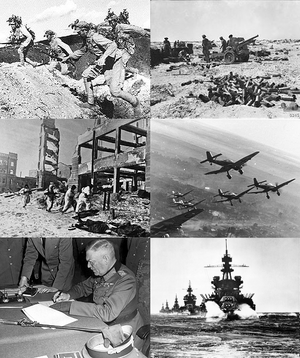
Back Tweede Wêreldoorlog Afrikaans Zweiter Weltkrieg ALS 2ኛው ዓለማዊ ጦርነት Amharic Segunda Guerra Mundial AN Ōðru Woruldgūþ ANG الحرب العالمية الثانية Arabic لحرب لعالمية الجاوجة ARY الحرب العالميه التانيه ARZ দ্বিতীয় বিশ্বযুদ্ধ Assamese Segunda Guerra Mundial AST
World War II, or the Second World War, was a global conflict involving all continents of the world, except Antarctica. It involved fighting in most of the world from 1939 to 1945. Some fighting started in 1937, when Imperial Japanese forces started the Second Sino-Japanese War. Most of the world's countries, including all of the great powers, fought as part of two military alliances: the Allied Powers and the Axis Powers.
The war involved more countries, cost more money, involved more people, and killed more people than any other war; 73 million people died,[1][2] most of whom were civilians. The war included massacres, a genocide called the Holocaust, strategic bombing, starvation, and disease. This was the only time a nuclear weapon was used in war.
The two sides were the Allies (at first China, Free France and the United Kingdom, joined by the Soviet Union, United States and others) and the Axis (at first Nazi Germany, Fascist Italy, and Empire of Japan and others).
The war in Asia began when Japan invaded China on July 7, 1937.[3] Combat in Europe began when The Third Reich of Germany invaded Poland on September 1, 1939. France and the United Kingdom reacted by declaring war on Germany. By 1941, most of Europe was under German control, including France, Norway, Austria, Hungary, Denmark, Czechoslovakia, and Poland. Only the British remained fighting against the Axis in North Africa, the Mediterranean, and the Atlantic. Germany gave up plans to invade Britain after losing the air Battle of Britain. In June 1941, Germany invaded the Soviet Union, starting the largest land invasion in history. On December 7, 1941, Japan attacked the United States at Pearl Harbor and invaded British and French colonies in Asia, and two fronts developed: the Western Theatre and the Pacific Theatre.
The Japanese victories were stopped in 1942, and the Soviets won the huge Battle of Stalingrad in early 1943. Then, the Allies started to win in multiple areas. The Axis were forced back from the Soviet Union, weakening in the Scorched Earth tactic. German leaders had not expecting the invasion to last till the hard Russian winter. The Axis also lost North Africa. Starting in 1943, they were forced to defend Italy. Allied forces had a hard time pushing into Italy from Sicily due to its strong defenses.[4] In 1944, the Allies invaded France. The invasion was called D-Day, held in June 6th, 1944. They came into Germany itself from the West, while the Soviets came in from the East. Germany surrendered on May 8 1945, ending the war in Europe.
Japan formally surrendered on September 2 1945, after the Soviets beat the Japanese in Manchuria and the United States dropped two nuclear bombs, "Little Boy" and "Fat Man," had been dropped on Hiroshima and Nagasaki, respectively. This was the only time a nuclear weapon has been used in a real war. As of the present day, the bombings of Hiroshima and Nagasaki have been the only instances in which nuclear weaponry has been used in wartime.[5]
After the war, the United Nations was set up to develop support between countries and to prevent future wars. After World War I, the League of Nations had been built, but it proved ineffective. The Cold War by the major winners soon started, but they did not fight each other in an actual war. The decolonization of Asia and Africa (where many places controlled by European countries were given their independence) happened as well since Europe had been weakened by the war. Economic recovery and political integration (the process of uniting countries) were among other results of the war.
Cite error: There are <ref group=lower-alpha> tags or {{efn}} templates on this page, but the references will not show without a {{reflist|group=lower-alpha}} template or {{notelist}} template (see the help page).
- ↑ Cite error: The named reference
deadwas used but no text was provided for refs named (see the help page). - ↑ Cite error: The named reference
The Second World War1was used but no text was provided for refs named (see the help page). - ↑ Cite error: The named reference
Holocaust Encyclopediawas used but no text was provided for refs named (see the help page). - ↑ "Nuclear Weapons – UNODA". Retrieved August 20, 2024.
